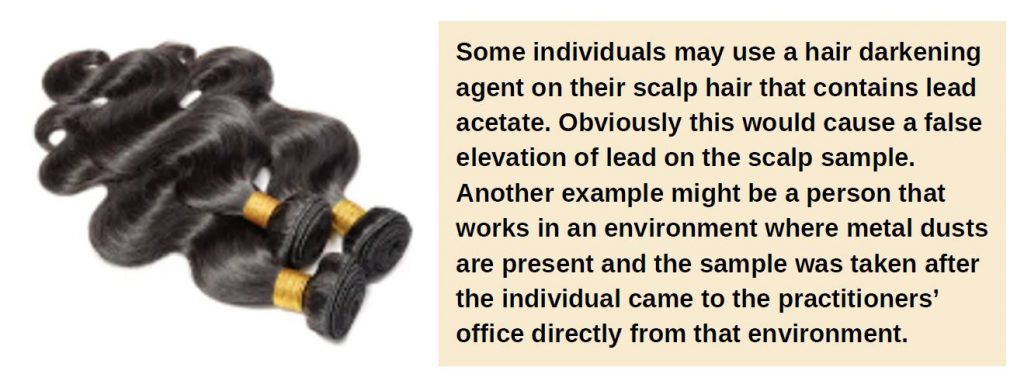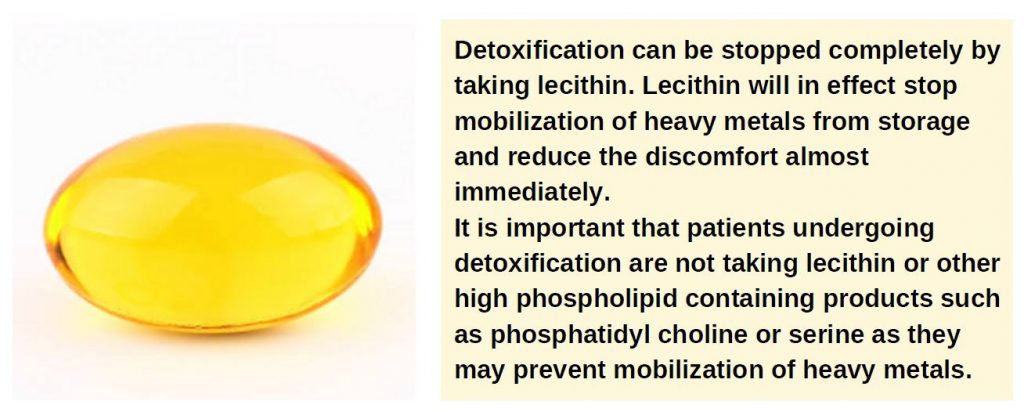
Hidden Heavy Metal Toxicity?
Hair Tissue Mineral Analysis
InterClinical eNews October 2019, Issue 97
Heavy metals are so ubiquitous in our environment that everyone is exposed to them. They cannot be avoided completely and are found in virtually everyone to some degree.
Sources of heavy metals range from environmental, occupational, household (including foods, water, paints, cosmetics, etc), medical and hobbies. Heavy metals can enter the body through inhalation, intestinal absorption as well as be absorbed through the skin depending upon their chemical form. Once absorbed into the body, heavy metals have a wide distribution in various organs, glands, bones and the central nervous system.
Hair Tissue Mineral Analysis (HTMA) measures nutritional minerals and heavy metals, and reflects the accumulation of these metals within the tissues of the body. This provides a record of long-term intake, retention, or excretion of various metals.
Can HTMA reveal recent exposure to a toxic element?
Of course the answer to this question is no. If a heavy metal such as arsenic was ingested, then the hair by virtue of its normal development and growth could not reveal the exposure until after it has been incorporated into the hair shaft. Therefore, it would take a minimum of thirty days for this to begin to occur. So, what should be the procedure if an elevated level of a heavy metal is actually found in a patient’s HTMA result?
How does the laboratory treat an elevated result?
When a heavy metal is found above a certain level in a specimen being analyzed, the test results for that specimen are flagged and the entire specimen is automatically placed on hold for verification.
The verification or recheck process involves the retesting of the specimen on a completely independent analytical run, which involves preparing another testing sample from the same original submittal specimen.
To retest, a second specimen is reweighed, redigested and given a follow-up analytical test. Verification requires the test value obtained by this second analysis to confirm the initial high test result for the heavy metal. When all controls and calibrations are within acceptable limits for both the initial analysis and the follow-up recheck, the original test results are released for report processing and delivery to the attending practitioner. In the event that the verification or recheck process does not confirm the initial elevated level, then the lab notifies the administrative department to request a new sample from the practitioner.
After the elevated level has been verified and the report has been sent to the practitioner, the next logical step is to rule out the possibility of an external source that may have inadvertently contaminated the sample before it was received in the laboratory.

A low level in a pubic sample retest may reveal that the high level from the original scalp sample was due to the possibility of external contamination. However, if the pubic sample test is also elevated, then it would definitely lead to the suspicion that an excess body burden does exist.
Practitioner Perspective
The practitioner should always take further steps when finding a markedly elevated heavy metal on a patient’s HTMA results. If an external contamination has been ruled out, the next step would be to determine if the exposure is on-going or if the exposure was from the past. A blood test would help to determine this. HTMA is limited and cannot determine when the exposure took place, so a blood test would indicate an on-going exposure. At this point the source of the heavy metal should be sought and eliminated as quickly as possible.
If the blood level is not elevated, then the HTMA results would indicate an exposure from sometime in the past. And since heavy metals are sequestered into tissues, the exposure could have been from months or even years prior. It should be noted that the estimated half-life of some heavy metals in the body can be up to fifteen years. Considering this, the practitioner would then have to take a careful and thorough history to find the possible source. Unfortunately, sometimes the source may never be identified.
False Positives
In many cases a false positive has clinical significance. It is well known that heavy metals contained in cosmetics, hair dyes etc., when applied to the skin, can be absorbed.
There have been numerous cases of mercury toxicity from skin lightening creams applied for the removal of age spots. Cosmetics and dyes containing lead acetate are also known to be absorbed into the body and can be a source of chronic accumulation. A false positive would indicate undue exposure to the element and care can be taken to avoid future contact. Even when blood tests show a false positive for a heavy metal such as lead, it is considered eminently better than a false negative.

Urine Heavy Metal Challenge
The drawback with a urine challenge is that it does not have reference ranges based upon a challenged range, and may not take into consideration the diet or fluid intake from previous days. Therefore, if the patient ingested seafood such as clams or tuna; the post challenge may show an elevation of mercury or arsenic and would not necessarily be reflective of body burden. Without these factors being taken into consideration, almost anyone would show a post challenge elevation of heavy metals since we are all exposed to heavy metals in the environment.
Another problem with a urine chelation challenge is that each heavy metal requires a different chelating agent. This would mean the test may need to be repeated many times to challenge multiple toxic elements.

Hidden Toxicity
This is a term often used to describe the possibility of the presence of excess heavy and toxic metals that are not shown to be elevated on the HTMA test. It is true that heavy metals can exert adverse metabolic effects even when not found in a high range on the HTMA test result. Results on the HTMA can indicate that heavy metals are stored or sequestered in organs and tissues throughout the body.
Lead and cadmium for instance are bone seekers and are eventually sequestered into the bone. As bone turnover occurs, lead and cadmium will constantly be released back into circulation and continually be incorporated into the hair shaft, therefore, revealing the chronic nature of exposure. With therapy aimed at rebalancing the mineral pattern, removal of lead and cadmium will be hastened and will result in higher levels on follow- up HTMA tests as greater amounts are being released from storage areas. In a sense this can be termed a hidden excess, but in reality it may be shown all along when one views the toxic mineral ratios.
Hidden toxicity is also used with nutritional minerals that can sometimes be toxic in excess, such as copper. The premise that it exists, is based upon symptoms and not confirmed from laboratory tests. Some practitioners may treat a patient based upon a possible toxicity rather than an actual toxicity.
Since no one can predict with certainty if a hidden toxicity exists or not, this therapy could instead produce an induced copper deficiency. There are of course exceptions, such as patients with Wilsons Disease. Wilson’s disease is a condition where there is little incorporation of copper into the hair shafts but excessive body burden or toxicity is in fact present and therapy is warranted.
Detoxification of Heavy Metals Burdens
After a heavy metal burden has been found on the HTMA or any other laboratory test, the first step is to identify and remove the source. Antagonism of heavy metals via the appropriate protective nutrients should be instituted depending upon the patient’s individual metabolic type and mineral interrelationships in order to reduce heavy metal body stores. Appropriate anti-oxidants are also important, as well as modification of the diet in order to further hasten the removal of heavy metals.
The patient’s diet should be adequate in protein and sulfur-containing amino acids which aid in the mobilization and transport of heavy metals to the eliminative organs. Correction of protein metabolism must also be addressed. Without adequate protein synthesis or the reduction in protein catabolism, detoxification will not occur with efficiency.
What Can Be Expected During Detoxification
Based upon the individuals HTMA test, metabolic status is assessed as well as nutritional interrelationships. Specific therapy aimed at rebalancing mineral pattern will aid the body in mobilizing and excreting the heavy metals that are present. This will usually begin within ten days to two weeks.
Some symptoms of detoxification may occur and depend upon the metal being mobilized and excreted. For example, cadmium is ultimately stored on the surface of the bones. Cadmium mobilization can cause aching of the long bones similar to flu symptoms. Lead however, is stored in the medullar portion of the bones and as lead is removed, joint pains or arthritic pains may arise.
These symptoms can last a few days and usually come and go as mobilization progresses. Over time, this will become less and less following the elimination. In some circumstances if the discomfort gets to the point that it may interfere with normal daily activities the detoxification process can be lessened or stopped completely by stopping or reducing the specific supplementation for a few days.

Follow-up laboratory results should show a significant change in heavy metals after two to three months on therapy, depending of course upon compliance and the metabolic type. HTMA results will show either an elevation of a heavy metal (if significant underlying amounts are present and are not being taken out swiftly), or at least a fifty percent reduction from the original level.
Therapy can then be modified or remain the same, depending upon changes noted in the mineral pattern and metabolic activity. There is apparently a priority system of elimination and if multiple heavy metals are present some will change but others may not significantly change as the body removes them. The removal is dependent upon metabolic changes and therefore, takes place in due course reducing the possibility that an undue burden or strain is laced upon the eliminative organs during the mobilization and removalH process.
By David Watts Ph.D Director of Research for Trace Element Inc. From TEI Newsletter Volume 20 No. 2
Copyright InterClinical Laboratories 2019, 2020. For more about InterClinical Laboratories Hair Tissue Mineral Analysis (HTMA) testing, visit here.
